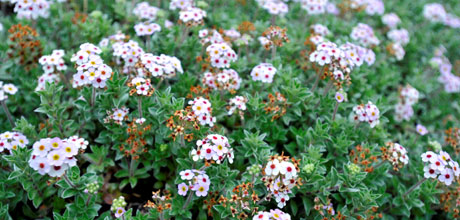Pink Enchantment from Tiny Flowers
This article was first published on 08 Feb 2012.

Androsace
Androsace lanuginose - there are several variations on pronunciation of this name, any one of which ends up sounding like a Harry Potter levitation spell. You may prefer to use the less arduous name, rock jasmine. It alludes to the masses of pink (but non-scented) flowers.
Native to mountains of western Himalaya, this stoloniferous perennial creeps along the ground and over obstacles. This makes it an excellent choice for tumbling over rocks and low walls as in the rock garden at the Dunedin Botanic Garden.
Tiny pointed leaves are clustered in whorls, and covered in dense silky white hairs, giving the plant a silvery look. In addition, the new interlacing stems are tinged red and provide early season allure before the flowers appear in summer and autumn.
Being a member of the primula family, the tiny flowers are five petalled. The blooms are produced en masse in terminal clusters, pink with a central yellow eye. When the flower has been pollinated, the eye turns dark pink, perhaps to let the bees know it’s not worth their while visiting.
The plant can look a little drab in winter, and care needs to be taken that it does not get too wet. There needs to be plenty of air circulation and the soil must be well drained.
Androsace lanuginose was first collected and described in 1824 by the Danish surgeon and botanist, Nathaniel Wallich, and has been in cultivation ever since - proof of its enduring style.
Robyn Abernethy is the Rock, Water & Alpine Collection Curator at Dunedin Botanic Garden.


